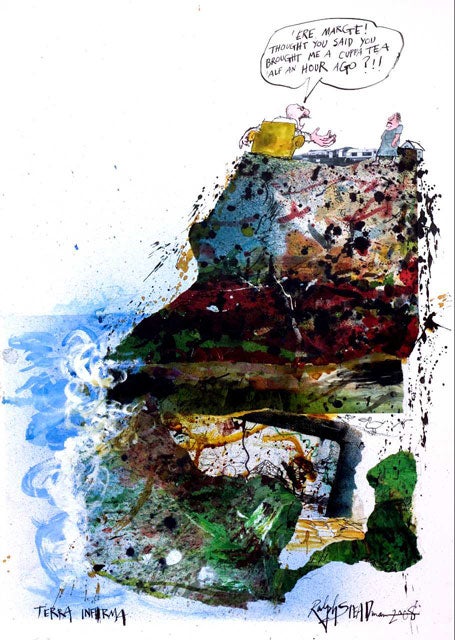Will Self: Slip slidin’away
PsychoGeography: Beyond Bridlington things got – as Alice would say – curiouser and curiouser

I conceived the idea of walking from Flamborough Head to Spurn Head, along the Holderness coast of East Yorkshire. It was about 60 miles and I could do it comfortably over three days. Why this walk along this coast? Well, the soil here – loess or clay – was deposited during the last ice age, and ever since then the longshore drift has been carrying it away to the south. The Holderness is, in point of fact, the fastest-eroding coast in Europe, with some six feet a year being lost to the North Sea.
I have distinct childhood memories of watching Nationwide, the BBC's evening TV current-affairs programme, and seeing the folksy presenter, Michael Barratt, with his distinctive 1970s hairstyle (like an ice-cream, melting asymmetrically over his brows), interviewing some poor householder who was sitting in one half of a room, while the other half had disappeared into a local void. "I can't oonderstand it," the householder was saying, with broad Yorkshire vowels. "I oonly poot those UPV windows in laast year and now loook what's 'appened!" To which – I understood even aged 12 – the only possible reply was: "Why the hell did you buy a house on the edge of a cliff, then?"
True, these may be screen memories of a screen – but the erosion was real enough. In January of this year there was a photo in The Independent of a house about to topple over the cliffs at Skipsea Sands, a third of the way along the coast, and that decided me: I would do the walk. I thought it would be strange enough seeing all these homeowners of the abyss, but stranger still was the notion that if I travelled the whole way within six feet of the cliff – or better still on the foreshore – I would be taking a walk that no one would ever be able to reproduce, because the very land itself would've disappeared within months.
Flamborough Head and Spurn Head are place names well enough known, as is the resort of Bridlington, but the rest of the coast – apart from its disappearing act – has no public profile at all. Perhaps it was this constant erasure that made it so secret? Half a mile or more had gone since the Roman era, scores of towns and villages had been inundated since Medieval times – could it be that such an ongoing diminution of once mighty, if always tiny, Albion was too much for us to face?
I left the train at Bempton and set off along roads, because there were no direct paths marked on the map. As ever under these circumstances, I feared for my life: in rural England the walker and the driver are pitted against one another: flesh versus steel; and while pedestrians may be a little self-righteous, it's nothing to compare with The Divine Right of Cars. Still, the fields were full of ripening wheat, the hedgerows with brambles, there were larks in the sky and soon enough I reached the bird reserve at the end of Flamborough Head, turning south-west past the white-painted lighthouse and along the grassy path beside chalk cliffs.
So far so conventional: cliffs a couple of hundred feet high, Bridlington with its Ferris wheel and roller coaster standing out five miles away in the haze. I walked on at a brisk pace, the cliff ever declining, until I reached the outskirts of the Victorian town, and strolled, a strange revenant, through its holiday crowds: the young people eating fat and sugar, the old and obese sitting in their electric wheelchairs, one of which was blazoned "Woodcock Assisted Mobility". But beyond Bridlington things got – as Alice would say – curiouser and curiouser. Soon enough the bathers and sand castle construction teams faded, the beach widened to half a mile or so, and there were men flying enormous kites, their parenthetic shapes bracketing sections of blue sky.
Flamborough and Spurn Heads were also shaped like two apostrophes, perhaps everything in between them was in quotes – or worse, ironised? There were concrete dragon's teeth strewn along the sands like the martial building blocks of gargantuan children, there were tip-tilting pillboxes on the bluffs above the beach, and suddenly I was entirely alone in all this sky, sand, loess and wheat.
I plodded on throughout the long, hot afternoon, while the chocolate bluffs mounted into cliffs and the concrete rubble on the beach grew and mutated. At about six I began to see the first struts and girders poking from the clay cliff, slippages of fresh earth marking the sign of recent falls, and sometimes sticking out from these, prosaic detritus: a sheet of galvanised iron, a roll of linoleum, a course of red bricks still mortared together – all of it instant archaeology. Chunky lumps of sea-rounded bitumen lay about on the beach, the biscuity remains of roadways dunked in the waves.
To be continued next week...
Join our commenting forum
Join thought-provoking conversations, follow other Independent readers and see their replies
Comments